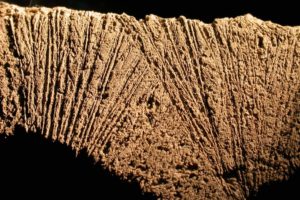
Those of us who live in northern latitudes would do well to review the basics of cold weather concreting every fall. The American Concrete Institute’s “Guide to Cold Weather Concreting” (ACI PRC306-16) summarizes what to do and why.
What do we mean by “cold weather”?
First of all, how cold is cold? For Floridians, 60 F might seem cold, while here in Minnesota people are still in shorts and T-shirts.
For concrete, the measure is more objective. As with any other chemical reaction, portland cement hydration proceeds more rapidly at higher temperatures. It slows to nearly zero at about 40° F. ACI PRC306-16 defines cold weather as “when air temperature has fallen to, or is expected to fall below, 40° F (4° C) during the protection period”.

The protection period lasts so long as either of two undesirable outcomes remains possible:
- If the concrete freezes prematurely (that is, before reaching a compressive strength of about 500 psi), the formation of ice crystals permanently damages its internal structure. It will never develop the necessary strength or durability.
- Even if it doesn’t freeze, it may not achieve the required strength and durability in time.
As we’ve discussed in a previous blog, hydration at elevated temperatures produces an unfavorable microstructure. Hard, dense shells of hydration products form near the cement grains, and large, continuous pores form between them. Conversely, hydration at low temperatures produces strong, low-permeability concrete; it just takes a long time.
When do you need it?
If you need to build on top of the concrete, posttension it, or remove the forms by a certain date, the rate of strength gain matters. Also, 500-psi concrete can withstand freezing once, but not repeated cycles of freezing and thawing.
ASTM C1074, “Standard Practice for Estimating Concrete Strength by Maturity Method,” allows you to determine the compressive strength of in-place concrete. You can calibrate it for your concrete when you’re doing the testing to qualify the mixture. You need at least 15 cylinders for maturity calibration. Embed thermocouples in two of them and record the time-temperature history. Use two cylinders to obtain the compressive strength at each of the test ages—usually 1, 3, 7, 14, and 28 days.
The time-temperature history of the in-place concrete will tell you when you can safely remove forms, posttension, or apply other loads. For cold weather concrete, maturity is more accurate than strengths from companion cylinders. That’s because companion cylinders don’t stay as warm as the in-place concrete, so they’ll gain strength much more slowly. The data you get from companion cylinders will be conservative, but you’ll waste a lot of time that you may not have. You also have only a limited number of cylinders to break. Maturity lets you work safely without blowing the schedule, and you can take all the strength readings you want.
Maturity data along with thermal modeling lets you predict and control the timing of strength gain. Thermal modeling allows you to try out “what if” scenarios to see the effects of, say, more insulation, weather changes, or additional heat. That way you can get your crews to the job at the right time and stay on schedule. You can also avoid problems such as thermal cracking and temperatures above the specified maximum.
Materials and mixture proportions
The less portland cement clinker in the concrete, the more sensitive to low temperatures it will be. That’s because portland cement clinker generates the most heat of hydration. Supplementary cementitious materials such as slag cement and fly ash benefit from that heat to activate their own hydration. When they hydrate, they generate heat as well, but less and more slowly than portland cement.
Type IL cements can contain up to 15% interground limestone. The limestone particles participate in hydration only by providing nucleation sites on which hydration products can form. By removing hydration products from solution, they accelerate these reactions somewhat. But they’re not reacting chemically themselves, and they’re not generating heat. Despite claims that Type IL is the same as Type I, it isn’t. It’s formulated to produce equivalent compressive strength at 28 days’ hydration at 73° F. Both Type I and Type IL cements hydrate and gain strength more slowly at low temperatures. However, at any given temperature, Type IL is slower than Type I and evolves less heat.
That makes Type IL cement less effective at activating supplementary cementitious materials, which you may need to meet performance or sustainability requirements. Fortunately there are other ways to activate them. You could moderately increase the placement temperature of the concrete, for example, and use enough insulation to maintain the temperature. Alkalis also help get the reactions going, so you might opt for a fly ash with a higher alkali content than you’d otherwise use. Accelerating admixtures are also available. However, don’t use chloride-bearing admixtures with steel reinforcement.
If you’re going to use these materials in cold weather concrete, you’d be wise to do some calorimetry ahead of time. That way you’ll have accurate data to include in the thermal modeling.
Preparing surfaces
Surfaces that will come into contact with the fresh concrete and spaces that will be filled with it must be free of snow, ice, and standing water. Formwork, base materials for slabs on ground, and massive metallic embedments may need to be heated before placing the concrete. Generally if the air temperature is at least 10° F, metal formwork and embedments do not require heating.
Do not place concrete on frozen ground. Also, it’s imperative that the temperature difference between the concrete and slab base material not exceed 20F°. The reason for this is that the concrete in direct contact with the base material will rapidly lose heat, so the surface will be much warmer than the base. The surface will set before the interior of the slab, so there’s no time at which finishers can trowel the surface—it’s beginning to stiffen, but the concrete beneath it won’t support the weight of the equipment.
Heating
Ideally, the right materials at the right proportions, along with an appropriate placement temperature and insulation, will attain the strength you need when you need it. If not, you can provide a heated enclosure.
For a building with a concrete slab on ground, it’s best to complete the structure before placing the slab. That way you protect the concrete not only from extreme cold, but also from wind, rain, and snow. Placing the concrete indoors also allows you to avoid entraining air. As we’ve discussed in a previous blog, air entrainment and hard troweling aren’t compatible, so if you need a hard-troweled surface, place the concrete after enclosing the structure.
Be sure to vent combustion heaters to the outside. Carbon dioxide (CO2) can carbonate the concrete surface, leaving it soft or crazed. Incomplete combustion can generate carbon monoxide (CO), which is hazardous to workers.
ACI PRC306-16 provides guidance for deciding on a placement temperature for the concrete. By heating the water and/or aggregates, you can obtain an appropriate placement temperature. However, too high a temperature may make the concrete difficult to mix properly. Warm concrete placed in cold conditions will experience more thermal contraction, which may generate cracking. And if you don’t protect the concrete surface from drying, you can end up with the same situation you’d face in hot weather: excessive drying that results in plastic shrinkage cracking. That’s because cold air is very dry, so it will readily take up moisture from the warm, wet concrete.
Protection period
How long you need to protect the concrete from freezing depends on its service conditions. For concrete subject to exposure classes F3, C2, or P1, the protection period continues until the concrete reaches the design strength. In addition, the strength must be sufficient to support any loads it will have to withstand.
Don’t remove insulation all at once, as rapid temperature drops can induce cracking. Loosen insulated forms and cover with polyethylene sheets to provide interim protection. That way the concrete can cool gradually.
